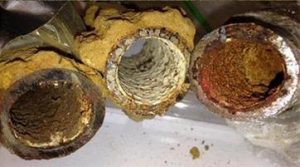KenWave Technology utilizes Dynamic Response ImagingTM technique, which represents the next evolution of condition assessment for critical assets with improved sensor sensitivity and the ability to collect multiple data types simultaneously, all with a focus on safety and ease of use.
Unlike acoustic leak detection which relies on leaks or flowing hydrants for a sound source, KenWave Technology uses a tunable valve box or a sonar to introduce test signals specific to each diameter and material combination, without any risk of water hammer.
Being an external tool, KenWave Technology can be attached to a variety of fittings so that it can inspect almost any watermain. Where fittings/valves are not available, both the wave generator and sensors can temporarily be attached directly to the external surface of the pipe.
A physics-based dynamic response model of pipes using ground propagation, dynamic loading, and impedance effects, gathers and analyzes the sensor data, with special post-processing to handle spurious noise such as from vehicle traffic.
Lastly, a thermodilatohydrometer or THD, uniquely allows KenWave Technology to correct for the effect of changes in water temperature, pressure, and dissolved gas content on the dynamic response dispersion curve.
First, the KenWave Field Team generates a multi-parameter dynamic response model for the pipe to be inspected. Test signals are then computed and introduced via the Wave Generator, which are measured downstream by the dynamic response sensors.
Then, KenWave compares the models with the measurements to deduce wall properties and anomaly locations. Results are then validated, and KenWave database and modeling algorithms are updated to make the next inspection more accurate.
What KenWave Technology Can Assess:
KenWave Technology can be used to inspect pipes filled with: potable water, wastewater, process-water, hot water, chilled water or glycol. KenWave Technology can inspect mixed material pipes, such as ductile iron with PVC repairs, as well as mixed diameter pipes. The following table summarizes the pipes which KenWave Technology can inspect and the type of data it provides.





